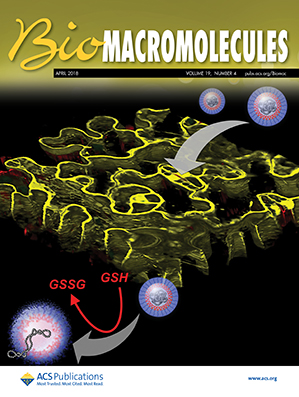磺胺基聚合物:在多种生物应用中结构修饰被低估的部分。
IF 5.4
2区 化学
Q1 BIOCHEMISTRY & MOLECULAR BIOLOGY
引用次数: 0
摘要
聚磺胺是一种具有三价磺胺基序的富硫阳离子聚合物,由于其高电荷密度、结构柔韧性和生物相容性,是一种很有前途的生物材料。这篇综述重点介绍了最近的合成策略:通过巯基/环氧树脂点击化学的主链聚合物和通过ROMP、ROP或RAFT聚合的垂链功能化,以及聚合后烷基化。它们的磺胺基选择性地破坏阴离子微生物膜,使其对MRSA等病原体具有广谱抗菌作用,而不会引起耐药性。刺激触发的解离增强细胞内递送,增强疗效,同时降低毒性。这些聚合物还通过磺胺-π相互作用稳定蛋白质,并通过两性离子或共价结构实现靶向治疗。可调的UCST/LCST行为和阴离子/pH响应性支持智能水凝胶用于伤口愈合和生物膜去除。与铵和磷类似物相比,聚砜具有优越的生物相容性和膜破坏能力,使其成为抗菌涂层、基因治疗和癌症治疗的理想选择。聚合物科学和生物技术之间的跨学科协同作用强调了它们在解决医疗保健和材料科学中的关键挑战方面的潜力。本文章由计算机程序翻译,如有差异,请以英文原文为准。
Sulfonium-Based Polymers: Underestimated Moieties for Structural Modification in Versatile Bioapplications
Polysulfoniums, sulfur-rich cationic polymers with trivalent sulfonium motifs, are promising biomaterials due to their high charge density, structural flexibility, and biocompatibility. This review highlights recent synthetic strategies: main-chain polymers via thiol–ene/epoxy click chemistry and pendant functionalization using ROMP, ROP, or RAFT polymerization, alongside postpolymerization alkylation. Their sulfonium groups selectively disrupt anionic microbial membranes, enabling broad-spectrum antibacterial action against pathogens like MRSA without inducing resistance. Stimuli-triggered dissociation enhances intracellular delivery, bolstering efficacy while reducing toxicity. These polymers also stabilize protein via sulfonium-π interactions and enable targeted therapies though zwitterionic or covalent architectures. The tunable UCST/LCST behavior and anion/pH responsiveness support smart hydrogels for wound healing and biofilm removal. Compared to ammonium and phosphonium analogs, polysulfoniums offer superior biocompatibility and membrane disruption, making them ideal for antimicrobial coatings, gene therapy, and cancer treatment. This interdisciplinary synergy between polymer science and biotechnology underscores their potential to address critical challenges in healthcare and materials science.
- Download: Download high-res image (172KB)
- Download: Download full-size image
求助全文
通过发布文献求助,成功后即可免费获取论文全文。
去求助
来源期刊

Biomacromolecules
化学-高分子科学
CiteScore
10.60
自引率
4.80%
发文量
417
审稿时长
1.6 months
期刊介绍:
Biomacromolecules is a leading forum for the dissemination of cutting-edge research at the interface of polymer science and biology. Submissions to Biomacromolecules should contain strong elements of innovation in terms of macromolecular design, synthesis and characterization, or in the application of polymer materials to biology and medicine.
Topics covered by Biomacromolecules include, but are not exclusively limited to: sustainable polymers, polymers based on natural and renewable resources, degradable polymers, polymer conjugates, polymeric drugs, polymers in biocatalysis, biomacromolecular assembly, biomimetic polymers, polymer-biomineral hybrids, biomimetic-polymer processing, polymer recycling, bioactive polymer surfaces, original polymer design for biomedical applications such as immunotherapy, drug delivery, gene delivery, antimicrobial applications, diagnostic imaging and biosensing, polymers in tissue engineering and regenerative medicine, polymeric scaffolds and hydrogels for cell culture and delivery.
 求助内容:
求助内容: 应助结果提醒方式:
应助结果提醒方式:


